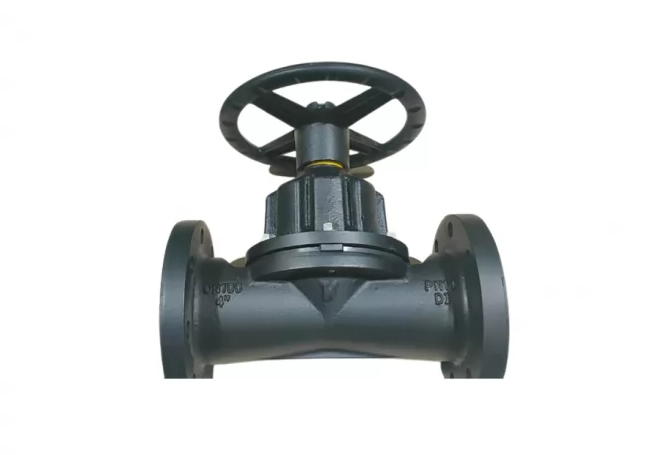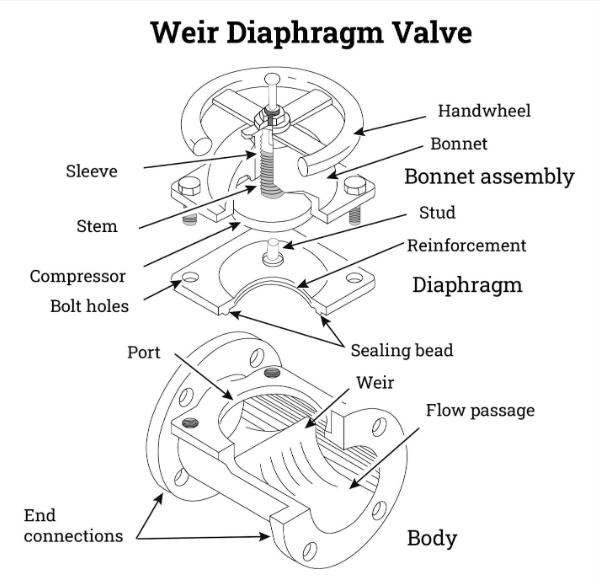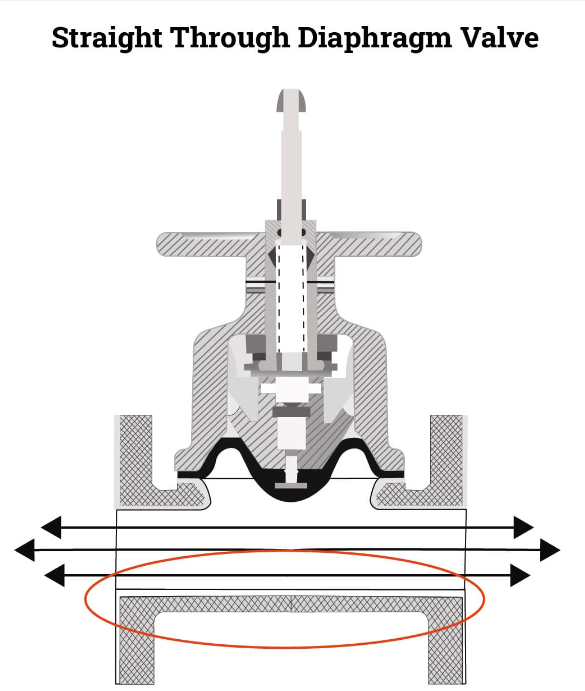Table 1: Article Outline |
1. Introduction |
2. What is a Diaphragm Valve? |
3. Working Principle |
4. Types of Diaphragm Valves |
5. Materials of Construction of Diaphragm Valves |
6. Advantages of Diaphragm Valves |
7. Disadvantages of Diaphragm Valves |
8. Applications of Diaphragm Valves |
9. Proper Installation and Maintenance |
10. Troubleshooting Common Issues |
11. How to Choose the Right Diaphragm Valve |
12. Industry Standards and Regulations |
13. Innovations in Diaphragm Valve Technology |
14. Sustainability and Diaphragm Valves |
15. Future Outlook |
16. Conclusion |
Diaphragm valves play a crucial role in controlling the flow of fluids in various industrial applications. Their unique design and functionality make them suitable for handling corrosive, abrasive, and high-purity fluids. In this article, we will explore the working principle, types, advantages, and applications of diaphragm valves. We will also discuss proper installation and maintenance, troubleshooting common issues, factors to consider when choosing a diaphragm valve, industry standards and regulations, as well as recent innovations and the future outlook of this essential valve technology.
A diaphragm valve is a type of valve that uses a flexible diaphragm to regulate the flow of fluids. The diaphragm acts as a barrier between the flow path and the valve body, preventing contact between the fluid and the valve components. This design ensures exceptional sealing properties and minimizes the risk of contamination or leakage.

Diaphragm valves can handle liquids, gaseous fluids, and semi-solid media such as slurries, colloids, sludges, and brackish water well. They are ideal for handling liquids with solid particulate matter.
The working principle of a diaphragm valve is based on the movement of a diaphragm, typically made of elastomer or other flexible materials. When the valve is in the closed position, the diaphragm seals against a weir or seat, blocking the flow of fluid. To open the valve, the diaphragm flexes or lifts away from the seat, allowing the fluid to pass through. This on-off action provides excellent flow control and prevents any backflow.
Diaphragm valves can be classified into various types based on their design and actuation mechanisms. Some common types include:
The weir type diaphragm valve features a raised weir or saddle-shaped seat. When the diaphragm is pressed against the seat, it forms a seal, preventing flow. This type of valve is widely used in applications where precise flow control is required.

The straightway diaphragm valve has a straight flow path, allowing for unobstructed flow when the valve is open. It is suitable for applications where minimal pressure drop and turbulence are desired.

The three-way diaphragm valve provides a third port for diverting or mixing fluid streams. It offers flexibility in controlling the flow direction and is commonly used in complex systems requiring multiple flow configurations.
Diaphragm valves offer several advantages that make them preferred choices in various industries:
The flexible diaphragm in a diaphragm valve provides exceptional sealing properties, ensuring tight shut-off and preventing any leakage or contamination.
Diaphragm valves are resistant to corrosion and abrasion, thanks to the choice of materials used in their construction. This makes them suitable for handling aggressive or abrasive fluids.
The on-off action of diaphragm valves allows for precise flow control, making them ideal for applications that require accurate dosing or throttling.
In industries such as pharmaceuticals and biotechnology, diaphragm valves are crucial for maintaining sterility and preventing contamination. They are often used in critical processes that require high-purity fluid control.
Diaphragm valves are relatively easy to maintain and clean. Their straightforward design and removable diaphragms simplify the cleaning process and minimize downtime.
The diaphragm material is typically made from a flexible, elastomeric material. However, these materials limit the temperature and pressure rating of the diaphragm valve, as they weaken at high temperatures and pressures. Diaphragm materials must be chosen based on the service temperature and pressure, nature of the material being handled, and frequency of operation.
Ethylene Propylene Diene Monomer (EPDM) is a synthetic, general-purpose elastomer. It has good corrosion resistance and is suitable for handling acids, alkalis, and alcohols. It is also resistant to ozone. However, it is not compatible with oil and petroleum products. EPDM is also suitable for steam sterilization. EPDM diaphragms operate between -20°F to 230°F.
Polytetrafluoroethylene (PTFE, or commonly known as Teflon) is a synthetic fluoropolymer. It has excellent corrosion and chemical resistance which are great in handling strong acids, alkalis, and solvents. Its stiffness creates a high sealing force but requires a larger force to operate. PTFE diaphragms operate between -300F to 3000F. To increase the compressive strength, wear and abrasion resistance, and pressure rating, PTFE is reinforced with glass fibers.
Neoprene is a synthetic rubber commonly used as a diaphragm material in wastewater pipelines. It has good corrosion and abrasion resistance. It can handle fluids with entrained oils, as wells as acids, alkalis, petroleum, explosives, and fertilizers. Neoprene diaphragms operate between -20°F to 200°F.
Butyl rubber has low vapor and gas permeability, making them ideal for gaseous media. It is also suitable for steam sterilization and can handle a variety of acids and alkalis. Butyl rubber diaphragms operate between -4°F to 248°F.
Nitrile rubber is a multi-purpose rubber that has high strength and abrasion resistance. It can handle gases, fuels, fats, oils, alcohols, and petroleum but are not compatible with acetones, ketones, ozone, and some modified hydrocarbons. Nitrile rubber diaphragms operate between -14°F to 134°F.
Natural rubber possesses good abrasion resistance and can handle moderate acids and alkalis. Natural rubber diaphragms are used in abrasives, dilute mineral acids, and brewing. These diaphragms operate between -40°F to 134°F.
Viton is a fluorocarbon elastomer. It has excellent resistance and compatibility with most chemicals, solvents, and oils, even at elevated temperatures. However, it is not recommended for steam sterilization and in handling ammonia and polar solvents. Viton diaphragms operate between -20°F to 300°F.
The valve body and the bonnet are made from a rigid and strong material to protect the diaphragm valve components. The bonnet can be made from a slightly less corrosion-resistant material since it is isolated from the wetted portion of the valve. To prevent clogging and gumming of sticky and viscous fluids, the inner diameter of the valve body may be smoothly-lined.
Like the diaphragm material, the valve body material must be corrosion resistant and can withstand sterilization requirements. To make the valve more sanitary, materials with antimicrobial properties (e.g., brass and bronze) may be chosen. The valve body can also be lined with materials with antimicrobial properties.
The common valve body materials for diaphragm valves include stainless steel, cast iron, ductile iron, cast steel, brass, bronze, PVC, U-PVC, and CPVC.
While diaphragm valves offer numerous advantages, they also have certain limitations to consider:
Diaphragm valves are not suitable for high-pressure or high-temperature applications due to the limitations of the diaphragm material.
Over time, the diaphragm in a diaphragm valve may wear out or become damaged, requiring replacement. Regular inspection and preventive maintenance are necessary to ensure optimal performance.
The flow path in a diaphragm valve may cause some degree of flow restriction, leading to pressure drop. Proper sizing and selection are crucial to minimize this restriction.
Diaphragm valves find applications in various industries, including:
In pharmaceutical and biotech processes, diaphragm valves are commonly used for aseptic fluid control, ensuring sterility and preventing contamination.
Diaphragm valves are suitable for handling corrosive chemicals and aggressive fluids in the chemical and petrochemical industries.
Diaphragm valves are employed in water and wastewater treatment plants for controlling the flow of chemicals, sludge, and other fluids.
In the food and beverage industry, diaphragm valves are used for hygienic fluid control, ensuring compliance with strict sanitary standards.
Proper installation and maintenance practices are crucial to ensure optimal performance and longevity of diaphragm valves. Some key considerations include:
Installing the diaphragm valve in the correct orientation ensures proper flow direction and prevents any potential issues.
Following the manufacturer's torque specifications when tightening fasteners ensures proper sealing without damaging the valve components.
Regular inspection and cleaning of diaphragm valves help identify any wear or damage and prevent the buildup of debris or contaminants.
Despite their reliability, diaphragm valves may encounter certain issues. Some common problems and their solutions include:
If a diaphragm valve experiences leakage, it is essential to check for any damage to the diaphragm or debris that may hinder proper sealing.
A sticking diaphragm can be resolved by cleaning or replacing the diaphragm, ensuring smooth movement and proper operation.
Diaphragm failure may occur due to wear, chemical attack, or excessive pressure. Regular inspection and replacement help prevent unexpected failures.
Selecting the appropriate diaphragm valve for a specific application requires careful consideration of several factors:
Considering the chemical compatibility of the fluid with the diaphragm material is crucial to prevent any adverse reactions or failure.
Evaluating the operating pressure and temperature range helps choose a diaphragm valve that can withstand the required conditions.
Understanding the flow characteristics of the fluid, such as viscosity and potential for clogging, aids in selecting the right diaphragm valve design.
Diaphragm valves must adhere to industry standards and regulations to ensure safety and reliability. Some important standards include:
The ANSI/ASME BPE (Bioprocessing Equipment) standard provides guidelines for the design and construction of equipment in bioprocessing industries, including diaphragm valves.
The U.S. Food and Drug Administration (FDA) regulations establish requirements for diaphragm valves used in the pharmaceutical and food industries to ensure product safety and quality.
The ISO 9001 certification signifies adherence to quality management systems, demonstrating a commitment to providing reliable and consistent products.
Continual advancements in diaphragm valve technology have led to various innovations, including:
Integration of sensors and actuators allows for remote monitoring and control, enabling predictive maintenance and optimizing process efficiency.
The development of advanced materials, such as high-performance polymers, expands the range of fluids and applications that diaphragm valves can handle.
Sustainability is becoming increasingly important in valve design and manufacturing. Diaphragm valves contribute to sustainability efforts through:
The ability to handle aggressive fluids without leakage or contamination minimizes the environmental impact and preserves natural resources.
Efficient flow control and minimal pressure drop in diaphragm valves contribute to energy savings and reduced operational costs.
The future of diaphragm valves looks promising, with ongoing research and development focused on:
Further advancements in diaphragm materials will expand the capabilities and compatibility of diaphragm valves.
The integration of the Internet of Things (IoT) and automation technologies will enhance the performance, monitoring, and control of diaphragm valves.
Diaphragm valves are versatile and reliable solutions for fluid control in various industries. Their unique design, excellent sealing capabilities, and compatibility with corrosive and high-purity fluids make them invaluable. By understanding the working principle, types, advantages, and applications of diaphragm valves, as well as implementing proper installation, maintenance, and troubleshooting practices, industries can optimize their processes and ensure efficient and reliable fluid control.
Q1. Can diaphragm valves handle both corrosive and abrasive fluids?
Yes, diaphragm valves are designed to handle corrosive and abrasive fluids. The choice of materials for the diaphragm and valve body ensures resistance to corrosion and abrasion.
Q2. Are diaphragm valves suitable for high-pressure applications?
Diaphragm valves have limitations when it comes to high-pressure applications. It is crucial to consider the pressure ratings specified by the manufacturer and select a valve accordingly.
Q3. How often should diaphragms be inspected and replaced?
The frequency of diaphragm inspection and replacement depends on various factors such as the application, fluid characteristics, and operating conditions. Regular preventive maintenance and visual inspections are recommended to identify any signs of wear or damage.
Q4. Can diaphragm valves be automated?
Yes, diaphragm valves can be automated using actuators and control systems. Automation allows for remote monitoring, precise control, and integration into larger process control systems.
Q5. Where can I find reliable diaphragm valve suppliers?
Reliable diaphragm valve suppliers can be found through online directories, industry-specific trade shows, or by consulting with industry experts. It is important to choose reputable suppliers known for their quality products and customer support.
Contact Us
Related Information
Types of Plug ValvesDiaphragm ValveClass 300 LB Plug ValveThe Difference between API 608 and API 6D Valve StandardWhat is the standard API for gate valves?Lubricated VS. Non-Lubricated Plug Valves: What You Need to KnowFlanged End Ball Valves - API 6DAPI 600 Gate Valve ManufacturerControl Valves: Everything You Need to KnowAPI 6D Ball Valve ManufacturersTrunnion Mounted Ball Valves Manufacturer5 Best Plug Valves Manufacturers and SuppliersTel:
+86 138 6861 8624
Tel(日本語対応):
+86 181 0553 1755
Email:
Email(日本語対応):
Keywords: Trunnion Mounted Ball Valves Manufacturer API 600 Gate Valve Manufacturer Types of Plug Valves Class 300 LB Plug Valve Lubricated VS. Non-Lubricated Plug Valves: What You Need to Know What is the standard API for gate valves? Control Valves: Everything You Need to Know 5 Best Plug Valves Manufacturers and Suppliers Diaphragm Valve API 6D Ball Valve Manufacturers Flanged End Ball Valves - API 6D The Difference between API 608 and API 6D Valve Standard

 CNM VALVE is your first choice for total valve solution. CNM VALVE is a total valve solution supplier which specializes in R&D, design, manufacture, sales, and service. View More
CNM VALVE is your first choice for total valve solution. CNM VALVE is a total valve solution supplier which specializes in R&D, design, manufacture, sales, and service. View More